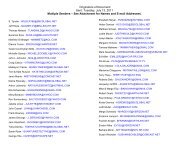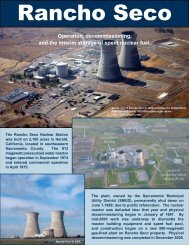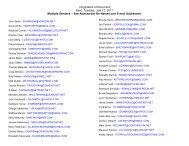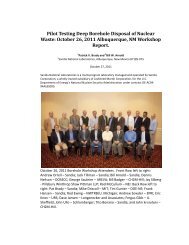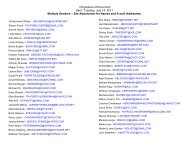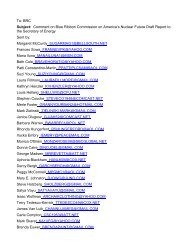Parametric Study of Front-End Nuclear Fuel Cycle Costs Using ...
Parametric Study of Front-End Nuclear Fuel Cycle Costs Using ...
Parametric Study of Front-End Nuclear Fuel Cycle Costs Using ...
Create successful ePaper yourself
Turn your PDF publications into a flip-book with our unique Google optimized e-Paper software.
1<br />
FRONT-END NUCLEAR FUEL COSTS<br />
In a previous report published in February 2009, EPRI provided an overview <strong>of</strong> the requirements<br />
for front-end nuclear fuel cycle components for light water reactor (LWR) uranium dioxide<br />
(UO 2<br />
) fuel, <strong>Parametric</strong> <strong>Study</strong> <strong>of</strong> <strong>Front</strong>-<strong>End</strong> <strong>Nuclear</strong> <strong>Fuel</strong> <strong>Cycle</strong> <strong>Costs</strong>, EPRI Report 1018574.<br />
That study examined front-end fuel cost components such as uranium concentrates, uranium<br />
conversion services, uranium enrichment services, and nuclear fuel fabrication services,<br />
including nominal unit costs for each <strong>of</strong> these components. The study included a parametric<br />
analysis <strong>of</strong> light-water reactor (LWR) fuel cycle costs in order to provide a basic understanding<br />
<strong>of</strong> the impacts that result from changes in the cost <strong>of</strong> one or more fuel cost components on<br />
overall fuel cycle costs.<br />
This study uses the methodology and builds on the results <strong>of</strong> EPRI Report 1018574 by<br />
evaluating the use <strong>of</strong> reprocessed uranium (RepU) in the place <strong>of</strong> natural uranium concentrates<br />
for the fabrication <strong>of</strong> LWR fuel for a pressurized water reactor (PWR). Assumptions for frontend<br />
fuel cycle unit costs are provided for the processing and manufacture <strong>of</strong> PWR fuel using<br />
natural uranium (NatU) and RepU.<br />
This study evaluates front-end nuclear fuel cycle costs assuming that uranium recovered during<br />
the reprocessing <strong>of</strong> commercial LWR spent nuclear fuel is recycled and used in the place <strong>of</strong><br />
natural uranium. Due to the additional costs associated with incorporating RepU in the LWR<br />
fuel cycle, this option is economically competitive only when the costs associated with front-end<br />
fuel cycle cost components in the non-RepU fuel cycle rise to a certain cost point. This report<br />
explores the relationship between the costs associated with using RepU compared to costs<br />
associated with a fuel cycle in which natural uranium is used exclusively.<br />
This study includes a parametric analysis <strong>of</strong> LWR fuel cycle costs, using RepU; and compares<br />
these costs to those <strong>of</strong> LWR fuel cycles using natural uranium concentrates. This parametric<br />
analysis assists in determining the impact <strong>of</strong> changes in front-end fuel cycle unit costs, including<br />
costs associated with processing RepU, on decisions regarding whether to utilize RepU<br />
inventories in the fabrication <strong>of</strong> LWR fuel. A brief background regarding the characteristics <strong>of</strong><br />
RepU is provided along with a description <strong>of</strong> front-end fuel cycle cost components, including the<br />
impacts <strong>of</strong> handling RepU.<br />
1.1 Reprocessed Uranium<br />
1.1.1 RepU Isotopic Composition<br />
RepU results from the chemical reprocessing <strong>of</strong> spent nuclear fuel in which the uranium and<br />
plutonium are separated from fission products using a solvent extraction process. RepU contains<br />
1-1


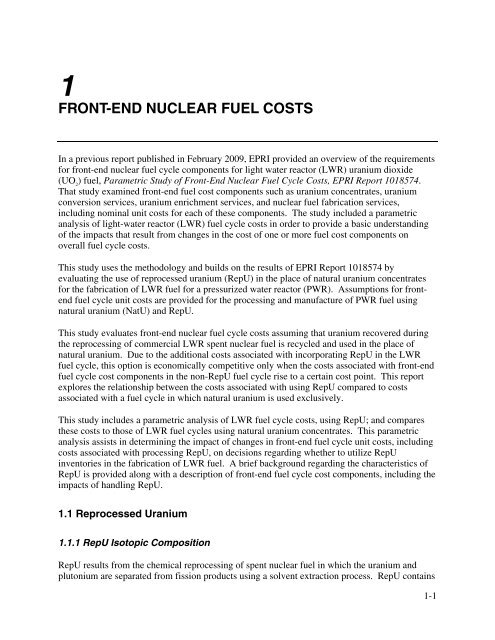
![Rainer Schottlaender[SMTP:RAINER.SCHOTTLAENDER@WEB.DE]](https://img.yumpu.com/51418350/1/190x245/rainer-schottlaendersmtprainerschottlaenderwebde.jpg?quality=85)
